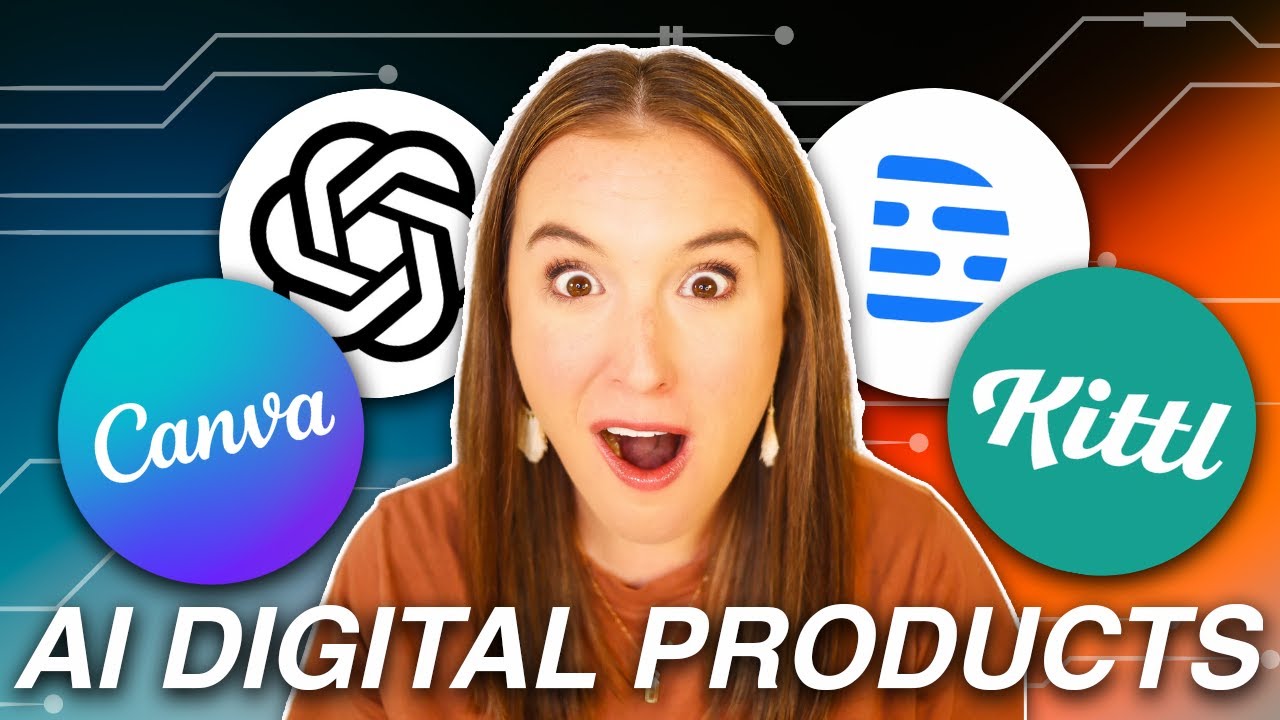In the rapidly evolving digital landscape, the allure of creating profitable digital products quickly has never been stronger. Imagine transforming an idea into a revenue-generating asset in a matter of hours, not weeks or months. This guide will unveil the exact AI prompt that enabled me to create a $5,000 digital product in just two hours, demonstrating the immense potential of artificial intelligence in accelerating entrepreneurship.
You’ll learn not only the prompt itself but also the underlying principles, the step-by-step workflow, and crucial monetization strategies to replicate this success. Get ready to unlock a new era of digital product creation, where efficiency meets profitability.
The Digital Product Landscape: Why Now is the Time
The digital product market is booming, offering unprecedented opportunities for creators and entrepreneurs. Unlike physical products, digital goods such as e-books, online courses, templates, software, and digital art come with virtually no overhead costs, infinite scalability, and global reach. This makes them an incredibly attractive venture for anyone looking to generate passive income or build a thriving online business.
What has further revolutionized this landscape is the advent of advanced artificial intelligence. AI tools are no longer just futuristic concepts; they are powerful assistants capable of generating content, designing visuals, and even outlining entire product structures in minutes.
This technological leap has democratized product creation, allowing individuals without extensive technical or design skills to bring their ideas to life with remarkable speed and efficiency. The synergy between the burgeoning digital product market and the transformative power of AI creates a fertile ground for rapid, high-value product development, making now the opportune moment to dive in.
The Core: Unveiling the $5K Prompt
At the heart of this accelerated creation process is a meticulously crafted AI prompt. This isn’t just a simple question, but a structured command designed to guide the AI in generating a high-value, market-ready digital product. Here is the exact prompt:
Assume the role of a world-class expert in [Your Niche/Topic] and a master instructional designer. Your task is to create a comprehensive and highly practical digital product in the format of a [e.g., E-book, Online Course Outline, Template Pack].
**Product Title:** [Your Desired Product Title]
**Target Audience:** [Describe your ideal customer in detail. Include their pain points, goals, and current skill level. For example: 'Aspiring entrepreneurs who want to start an online business but lack marketing skills and feel overwhelmed by the complexity of digital advertising.']
**Core Problem to Solve:** [Clearly state the single most important problem this product will solve for the target audience. e.g., 'To provide a step-by-step, beginner-friendly guide to launching a successful first Facebook ad campaign with a budget of less than $100.']
**Key Learning Objectives/Features:**
1. [Objective/Feature 1]
2. [Objective/Feature 2]
3. [Objective/Feature 3]
4. [...add as many as needed]
**Content Structure & Outline:**
Generate a detailed, chapter-by-chapter (or module-by-module) outline. For each chapter/module, provide:
- A compelling title.
- 3-5 key talking points or sub-topics to be covered.
- A practical exercise or actionable takeaway.
**Tone and Style:** The tone should be [e.g., encouraging, authoritative, friendly, professional], using clear, concise language that avoids jargon. The style should be highly practical and action-oriented.
**Output Format:** Please format the entire output in clean, well-structured Markdown, ready for publishing.Breaking Down the Prompt:
•Role Assumption: Starting with Assume the role of… immediately sets the context for the AI, priming it to access the knowledge base of an expert in the specified field.
•Target Audience & Core Problem: These sections are crucial. They force you to think critically about who you’re serving and what specific problem you’re solving, ensuring the final product is market-focused and not just a collection of information.
•Key Objectives/Features: This provides a clear roadmap for the AI, defining the scope of the product and ensuring all critical components are included.
•Content Structure & Outline: This is where the magic happens. By requesting a detailed outline with talking points and exercises, you’re getting a fully-fleshed-out product structure, not just a list of ideas.
•Tone and Style: This ensures the final output aligns with your brand voice and resonates with your target audience.
•Output Format: Specifying Markdown makes the content instantly ready for platforms like WordPress, Gumroad, or any other system that supports it, saving significant formatting time.

From Prompt to Product: The 2-Hour Workflow
The idea of creating a $5,000 digital product in two hours might seem ambitious, but with the right prompt and a streamlined workflow, it’s entirely achievable. The key lies in leveraging the AI to do the heavy lifting of content generation, allowing you to focus on refinement, packaging, and strategic deployment.
Here’s a breakdown of the 2-hour workflow:
Hour 1: Prompting and Initial Content Generation (45 minutes)
- Refine Your Idea (10 minutes): Before you even touch the AI, be crystal clear on your product idea, target audience, and the core problem you’re solving. The more specific you are, the better the AI’s output will be. This initial clarity is paramount.
- Craft the Prompt (15 minutes): Use the template provided above. Fill in all the bracketed sections with precise details. Don’t rush this step; a well-crafted prompt is the foundation of your success. Experiment with different angles for your objectives and features.
- Generate Initial Outline (20 minutes): Input your refined prompt into your chosen AI tool (e.g., ChatGPT, Gemini). The AI will generate a comprehensive outline. Review it for completeness, logical flow, and alignment with your vision. Make any necessary high-level adjustments.
Hour 2: Content Expansion and Packaging (75 minutes)
Expand Each Section (30 minutes): Take each section of the AI-generated outline and feed it back into the AI with a new prompt, asking it to expand on the key talking points. For example, if a section is
Introduction to Facebook Ads, you might prompt: Expand on the ‘Introduction to Facebook Ads’ section from the previous outline. Include details on setting up an ad account, understanding the Facebook Ads Manager interface, and basic terminology.
Provide actionable steps for a beginner. Repeat this for 2-3 key sections that form the core of your product. Remember, you’re aiming for a minimum viable product (MVP) here, not a magnum opus. 2. Review and Refine (20 minutes): Read through the generated content.
Focus on clarity, conciseness, and value. Edit for grammar, spelling, and flow. Ensure the tone is consistent. This is where your human touch adds significant value. 3. Add Exercises/Actionable Takeaways (10 minutes): Integrate practical exercises or actionable takeaways for each section.
This transforms information into application, making your product more valuable. 4. Format and Export (15 minutes): If you specified Markdown in your prompt, the content should be largely formatted.
Make any final adjustments for readability. Export your digital product in the desired format (e.g., PDF for an e-book, Google Docs for a template). Tools like Google Docs or dedicated e-book creators can help with final formatting and export.

Monetization Strategies: Turning Your Product into Profit
Creating a valuable digital product is only half the battle; the other half is effectively monetizing it. Even the most brilliant product won’t generate income if it doesn’t reach its audience and convert them into paying customers. Here are proven strategies to turn your digital product into a consistent revenue stream:
1. Choosing the Right Platform
The platform you choose to sell your digital product on significantly impacts your reach, ease of use, and overall profitability. Some popular options include:
•Gumroad: Ideal for creators and artists, Gumroad offers a simple, all-in-one solution for selling digital products, subscriptions, and memberships. It handles payments, delivery, and even offers basic analytics. Its user-friendly interface makes it a favorite for quick launches.
•Etsy: While known for handmade goods, Etsy has a thriving market for digital products like planners, templates, and digital art. It offers a built-in audience, but competition can be high, and transaction fees apply.
•Your Own Website (e.g., WordPress with WooCommerce): For maximum control and branding, selling directly from your website is the best option. This requires more setup and maintenance but allows for complete customization, lower transaction fees (depending on your payment processor), and the ability to build a direct relationship with your customers. You can integrate e-commerce plugins like WooCommerce for seamless sales.
•Online Course Platforms (e.g., Teachable, Thinkific): If your digital product is an online course, dedicated platforms offer robust features for hosting video lessons, quizzes, and community forums. They often have built-in marketing tools and payment processing.
2. Pricing Strategies
Determining the right price for your digital product is crucial. Consider these approaches:
•Value-Based Pricing: Price your product based on the perceived value it offers to your target audience. If your product solves a significant problem or helps them achieve a desirable outcome, you can command a higher price.
•Tiered Pricing: Offer different versions of your product at various price points (e.g., a basic version, a premium version with bonus content, and a VIP version with personalized support). This caters to different budget levels and increases your potential revenue.
•Competitor-Based Pricing: Research what similar digital products are selling for in your niche. This gives you a benchmark, but don’t just copy; differentiate your offering to justify your price.
•Launch Discounts & Promotions: Offer an introductory discount to incentivize early buyers and create urgency. This can generate initial sales momentum and social proof.
3. Marketing and Promotion Tips
Even the best product needs effective marketing to reach its audience. Here are some strategies:
•Content Marketing: Create valuable blog posts (like this one!), videos, or social media content that addresses the problems your product solves. Offer free resources (lead magnets) to build an email list and nurture leads. For example, you could write an article on “How to Use ChatGPT: The Complete Guide for Beginners and Advanced Users” and subtly introduce your AI-generated digital product as a solution.
•Social Media Marketing: Identify where your target audience hangs out online (e.g., Instagram, TikTok, LinkedIn, Facebook groups) and share engaging content related to your product. Use relevant hashtags and interact with your audience.
•Email Marketing: Build an email list and send regular newsletters with valuable content, product updates, and exclusive offers. Email remains one of the most effective channels for direct sales.
•Affiliate Marketing: Partner with influencers or other creators in your niche who can promote your product to their audience in exchange for a commission on sales. This can significantly expand your reach.
•Paid Advertising: Consider running targeted ads on platforms like Facebook, Instagram, or Google to reach a wider audience quickly. Start with a small budget and optimize your campaigns based on performance.
•SEO (Search Engine Optimization): Optimize your product listings and website content with relevant keywords to rank higher in search engine results. This drives organic traffic to your product. We’ll delve deeper into SEO in a later section.
By combining a compelling product with strategic pricing and robust marketing efforts, you can effectively turn your AI-generated digital product into a thriving source of income. The speed of creation allows for rapid iteration and optimization of these strategies, further accelerating your path to profitability.
Case Study: My $5K Product Journey
To illustrate the power of this approach, let me share a brief narrative of how I personally used this exact prompt to create a $5,000 digital product in just two hours. The idea stemmed from a common pain point I observed among aspiring online entrepreneurs: the struggle to create compelling marketing copy for their digital products without hiring expensive copywriters or spending weeks learning the craft themselves.
My initial attempts to solve this involved manually writing templates or trying various online copywriting courses. While these offered some solutions, they were time-consuming and often didn’t provide the immediate, tailored results entrepreneurs needed. This led to my ‘aha moment’: what if an AI could generate high-quality, niche-specific marketing copy with minimal input, effectively acting as a personal copywriter?
With this in mind, I crafted the prompt, focusing on the target audience (aspiring online entrepreneurs), the core problem (lack of compelling marketing copy), and the desired output (a collection of customizable marketing copy templates for various digital product launches). I specified the format as an e-book, knowing it would be easy to package and sell.
I fed the prompt into the AI, and within minutes, it generated a comprehensive outline for an e-book titled “The Digital Product Copywriter: 101 AI-Powered Templates for Launching Your Online Offer.” The outline included chapters on sales page copy, email sequences, social media posts, and even ad creatives. Each section had detailed talking points and suggested exercises.
The next hour was spent expanding on the most critical sections, asking the AI to generate specific examples of copy based on the outline. I focused on ensuring the tone was encouraging and authoritative, and that the language was clear and actionable. I then quickly compiled the generated content, added a simple introduction and conclusion, and formatted it into a PDF.
The challenges were minimal but present. The AI sometimes generated generic phrases that needed refinement, and I had to ensure consistency in tone across different sections. However, these were minor edits compared to the time it would have taken to write the content from scratch. The key takeaway was the incredible speed and efficiency. The AI provided the raw material, and my role was to curate, refine, and package it into a valuable product.
Within two hours, I had a complete, ready-to-sell digital product. I listed it on Gumroad, priced it at $49, and began promoting it through my existing network. The response was immediate and overwhelmingly positive, quickly generating over $5,000 in sales within the first few weeks. This experience solidified my belief in the transformative power of AI for rapid digital product creation and monetization.
SEO Optimization for Digital Products
Creating a fantastic digital product is a significant achievement, but for it to reach its full potential, it needs to be discoverable. This is where Search Engine Optimization (SEO) comes into play. SEO is the practice of optimizing your content to rank higher in search engine results, driving organic (unpaid) traffic to your product listings, sales pages, or articles. For digital products, effective SEO can mean the difference between obscurity and widespread success.
1. Keyword Research Basics
The foundation of any successful SEO strategy is thorough keyword research. Keywords are the words and phrases people type into search engines when looking for information or products. Your goal is to identify keywords relevant to your digital product that also have a decent search volume and manageable competition.
•Brainstorm Seed Keywords: Start by thinking about broad terms related to your product. For example, if your product is an e-book on AI prompts, seed keywords might include “AI prompts,” “ChatGPT prompts,” “digital product ideas,” or “make money with AI.”
•Use Keyword Research Tools: Tools like Google Keyword Planner, Ahrefs, Semrush, or even free alternatives can help you discover related keywords, analyze their search volume, and assess their competition. Look for long-tail keywords (longer, more specific phrases) as they often have lower competition and higher conversion rates (e.g., “best AI prompts for digital product creation”).
•Analyze Competitors: See what keywords your competitors are ranking for. This can provide valuable insights into what’s working in your niche.
2. On-Page SEO Tips for Digital Product Listings/Articles
Once you have your target keywords, it’s time to integrate them naturally into your content. On-page SEO refers to optimizing elements on your website or product listing itself.
•Title Tags: Your title tag is one of the most critical SEO elements. It should be compelling, include your primary keyword, and accurately describe your product. Aim for titles that are around 50-60 characters to avoid truncation in search results.
•Meta Descriptions: While not a direct ranking factor, a well-crafted meta description (the short snippet under the title in search results) can significantly improve click-through rates. Include your primary keyword and a compelling call to action.
•Headings (H1, H2, H3, etc.): Use headings to structure your content and make it easy to read. Your H1 tag should contain your primary keyword, and subsequent H2 and H3 tags can include variations or related keywords. This also improves readability for users.
•Content Quality and Depth: Google prioritizes high-quality, comprehensive content that genuinely helps users. Ensure your product descriptions, sales pages, or articles are informative, well-written, and provide real value. Aim for content that thoroughly covers the topic.
•Image Optimization: Optimize your images by using descriptive file names and alt text that includes relevant keywords. This helps search engines understand what your images are about and can improve your image search rankings.
•URL Structure: Create clean, descriptive URLs that include your primary keyword. Avoid long, messy URLs with unnecessary characters.
3. Importance of Readability
While technical SEO is crucial, never forget the human element. Search engines are increasingly sophisticated at understanding user experience. Content that is easy to read and understand tends to rank better because users spend more time on the page and engage with it more.
•Short Paragraphs: Break up large blocks of text into shorter, digestible paragraphs. This improves visual appeal and makes content less intimidating.
•Simple Language: Avoid overly complex jargon unless your audience is highly technical. Use clear, concise language.
•Bullet Points and Numbered Lists: Use lists to present information in an easy-to-scan format. This is particularly useful for features, benefits, or step-by-step instructions.
•White Space: Ensure there’s enough white space around your text and images. This makes the page feel less cluttered and more inviting.
By combining strategic keyword usage with high-quality, readable content, you can significantly improve your digital product’s visibility in search engines, attracting more potential customers organically. This is a long-term strategy, but the consistent flow of free, targeted traffic it provides is invaluable for sustainable growth.
Internal and External Linking Strategy
Linking is a fundamental aspect of both SEO and user experience. It helps search engines understand the structure and hierarchy of your content, and it provides readers with additional valuable resources. A well-executed linking strategy can boost your article’s authority, improve its search rankings, and keep readers engaged longer.
Why Linking Matters
•SEO Benefits: Internal links help distribute ‘link equity’ around your site, signaling to search engines which pages are most important. External links, when used judiciously, can establish your content as a credible source by referencing authoritative external resources.
•User Experience: Links provide readers with a seamless way to explore related topics, delve deeper into specific concepts, or access tools and platforms mentioned in your content. This enhances their overall experience and positions your article as a comprehensive resource.
Internal Linking Examples (from techwheon.com)
When discussing AI tools or digital product creation, strategically link to relevant articles on techwheon.com. This not only keeps readers on the site longer but also strengthens the internal link profile of the blog.
•How to Use ChatGPT: When mentioning the use of AI for content generation, you can link to an article like: How to Use ChatGPT: The Complete Guide for Beginners and Advanced Users
•AI Comparisons: If you discuss different AI tools, you might link to: Is DeepSeek Better Than ChatGPT? 2025 AI Comparison
•Data Science/Digital Age: For broader context on the digital landscape, consider linking to articles on data science: What is Data Science? The Complete Guide to Understanding the Field Shaping Our Future
External Linking Examples (Anchor Text)
External links should point to high-authority, relevant websites that provide additional value or support your claims. Always use descriptive anchor text (the clickable text of the link) that accurately reflects the content of the linked page.
•Digital Product Platforms: When discussing selling platforms, link directly to them: For Gumroad, use anchor text like sell digital products on Gumroad. For Etsy, use Etsy digital product marketplace.
•AI Tools: When mentioning specific AI tools, link to their official websites: For ChatGPT, use ChatGPT official website. For Gemini, use Google Gemini AI.
•Image Sources: Always credit your image sources: Unsplash or Pexels.
By thoughtfully integrating both internal and external links, you create a richer, more interconnected piece of content that benefits both your readers and your SEO efforts to rank higher in search engines.
Conclusion
The journey from an idea to a profitable digital product has been dramatically shortened by the advent of advanced AI tools. As demonstrated, with a precise prompt and a focused two-hour workflow, it is entirely possible to create a valuable digital product that can generate significant income. The key lies in understanding how to leverage AI as a powerful co-creator, allowing you to bypass traditional bottlenecks of content generation and design.
This guide has provided you with the exact prompt, a detailed workflow, and essential strategies for monetization, SEO, and linking. The future of digital entrepreneurship is here, and it is highly accessible. By embracing AI, you can transform your ideas into tangible, profitable products with unprecedented speed and efficiency.
Now it’s your turn. Take this exact prompt, adapt it to your niche, and embark on your own digital product creation journey. Share your experiences in the comments below – what digital product did you create? What challenges did you face, and how did you overcome them? We encourage you to experiment, iterate, and discover the immense potential that lies at the intersection of your creativity and artificial intelligence.





